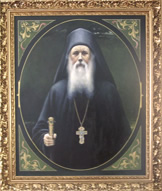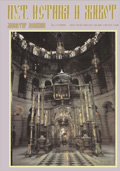MANASTIR LEPAVINA - SRPSKA PRAVOSLAVNA CRKVA

- BRATSTVO MANASTIRA
- ISTORIJA MANASTIRA
- KAKO DO MANASTIRA
- DUHOVNE POUKE
- MANASTIRSKA IZDANJA
- INTERNET BIBLIOTEKA
- INTERVJUI
- ČUDA BOŽJA
- PODVIŽNICI
- ARHIVA
- PITANJA I ODGOVORI

ST. MILOS AND THE PASCHA EGG
 Saints reveal themselves in marvelous ways, and last spring, while in Patras, Greece, researching an interview on St. Andrew’s journeys (Fall 2004), Road to Emmaus staff had coffee with Mrs. Smaragda Pavlou, a Patras native, whose surprising Pascha story was a highlight of our visit. Hesitant at first to have the story recorded, at the urging of her spiritual father, Smaragda agreed:
Saints reveal themselves in marvelous ways, and last spring, while in Patras, Greece, researching an interview on St. Andrew’s journeys (Fall 2004), Road to Emmaus staff had coffee with Mrs. Smaragda Pavlou, a Patras native, whose surprising Pascha story was a highlight of our visit. Hesitant at first to have the story recorded, at the urging of her spiritual father, Smaragda agreed:It was Great Thursday, 1939, and my sister Photini and I were young girls. Great Thursday was the day we dyed our Pascha eggs, and we had saved many eggs during the fast. Patras was not crowded in those days; we had land behind our house for chickens, and that year we had a new young hen among our brood. On the morning of Great Thursday, she laid her first egg
and immediately died. We were very surprised and felt great pity for her, so we took the egg and included it with the others we were dying red for Pascha. On Great Saturday, the eggs were blessed in church, the parish of St. Dionysios on Astings Street, and after the Pascha liturgy, one egg was selected to be put into the icon corner as a blessing for the year. That Pascha we chose the egg from the little hen that had died, and set it in the icon case. A few months later, on the morning of November 10, for no obvious reason, the egg fell from the icon case and broke with a loud crack. Amidst the
fragments of the shell, we found a tiny black wax-like oval medallion, with a figure in a phelonion and omophore1 with the Holy Gospel in his hand, and the name “Agios Milos” (St. Milos) etched around the figure in capital letters. On the opposite side, without words, was the familiar image of St. Stylianos, holding an infant.2 It seemed to us that the dried up contents of the egg had shaped themselves into an Icon-Not-Made-By-Hands. I asked everyone I knew who St. Milos was, but no one had ever heard of him, not even the priest.
[1 Felonion and omophore: Orthodox bishop’s vestments.
2 St. Stylianos: Monk of Paphlagonia, prayed to in the Greek tradition for women in childbirth and for infants. Feast-day, Nov. 26.]
Everyone in our family saw this wonderful icon from the egg. We knew that St. Milos had come to us, and we all prayed to him. For a whole year afterwards, people came to our home to venerate the tiny icon; our house became like a public shrine. Then, Greece was invaded. It was 1940, and the Italians bombed Patras. Many people fled to our home for safety, because of the presence of the
icon. And indeed, our house was one of the few left standing after the bombing. All of the men in our family had gone to fight the Italian and German invaders, and each took with him a bit of the broken egg-shell sewn into little pieces of cloth as a protection. During the war, our neighbors lost one, two, three, sometimes all the men in their family, but not one of our relatives was killed in World War II or in the civil war that followed. Bombs fell around them, bullets and explosions hit soldiers next to them, but they were unharmed. More than once, they were the only ones left untouched in their company, and we knew this was only through the saint’s prayers. In Greece at that time, our women were still having babies at home, and because the doctors were needed for the army, we often had to help them ourselves. When neighbors were having hard deliveries, my sister and I would take the little icon to bless them. We would pray to St. Milos and St. Stylianos and always the birth would become easier and the baby born well. Many times, women hemorrhaging in childbirth were helped after being blessed with the icon. The hemorrhage would just stop. No one ever died after venerating the icon. But who was this St. Milos? None of us knew. I asked many educated people and many priests, but none had ever heard of him, until twenty years ago when a pious Christian from Athens, who had come to venerate the icon, told the story to a young theologian. The theologian heard this story on the night of November 9, and he was filled with a desire to know who this saint was. The next morning, as he read the names of the saints of the day from the Menaion for November 10, he saw: “Also celebrated today is Saint Milos (or Melisios) the Wonder-Worker, Hieromartyr of Persia.”
He found that St. Milos was a fourth-century bishop in Babylon, consecrated after years of asceticism in the wilderness by Bishop Gennadios of Persia (modern-day Iran). The Persian church at that time was deeply mired in crime, sin, and sloth, and Milos’ attempts to correct the people went unheeded. Warning that they were offending the state as well as God, he urged them to repent before their crimes brought the wrath of the civil authorities upon them. They derided him, and seeing that their situation was hopeless, he announced that he was departing and would return only after they had reaped a harsh punishment for their misdeeds. St. Milos then left for the Holy Land, where he lived for two years with St. Ammon, the disciple of St. Anthony the Great. The wayward population was soon punished – the ruler of Babylon put thousands to the sword and loosed a battalion of three hundred elephants that crushed everything in its path. When St. Milos returned, he set to work
restoring the faith of those who had survived. His success was met with acclaim throughout Persia but also with jealousy, and in 357, he and four others from his diocese were imprisoned. Those with him were stoned to death, while St. Milos was first tortured, and then used as a living target for the sport of the local ruler and his brother. Before he died, pierced by their arrows, he prophesied that both of his executors would perish in the same way, and soon after, as they hunted in the forest, a deer leaped out between them. Each brother loosed his arrow, only to have it penetrate the other’s heart. The theologian was so moved by his providential hearing of the story on the eve of the saint’s own feast that he founded the Society of St. Milos among the Orthodox of Patras, and is now building a church dedicated to St. Milos, to the glory of God.
source http://www.roadtoemmaus.net/back_issue_articles/RTE_20/St_Milos_and_The_Pascha_Egg.pdf
ARCHIMANDRITE GAVRILO
Dear visitors of our web-site of the monastery Lepavina! Due to a high number of visits of our website, I am honoured to take the responsibility to describe you in English different events from Serbian Orthodox Church and monastery Lepavina. We would like to inform you that we will be also putting on our web-site some texts in English on different subjects from other Orthodox websites. I deeply hope and believe that our Lord will help me in that!
With God’s blessing, from monastery Lepavina Archimandrite Gavrilo.
Biography Archimandrite Gabriel (Vuckovic)
Dear visitors of our web-site of the monastery Lepavina! Due to a high number of visits of our website, I am honoured to take the responsibility to describe you in English different events from Serbian Orthodox Church and monastery Lepavina. We would like to inform you that we will be also putting on our web-site some texts in English on different subjects from other Orthodox websites. I deeply hope and believe that our Lord will help me in that!
With God’s blessing, from monastery Lepavina Archimandrite Gavrilo.
Biography Archimandrite Gabriel (Vuckovic)


Njegovo Visokopreosveštenstvo Mitropolit G. Porfirije









